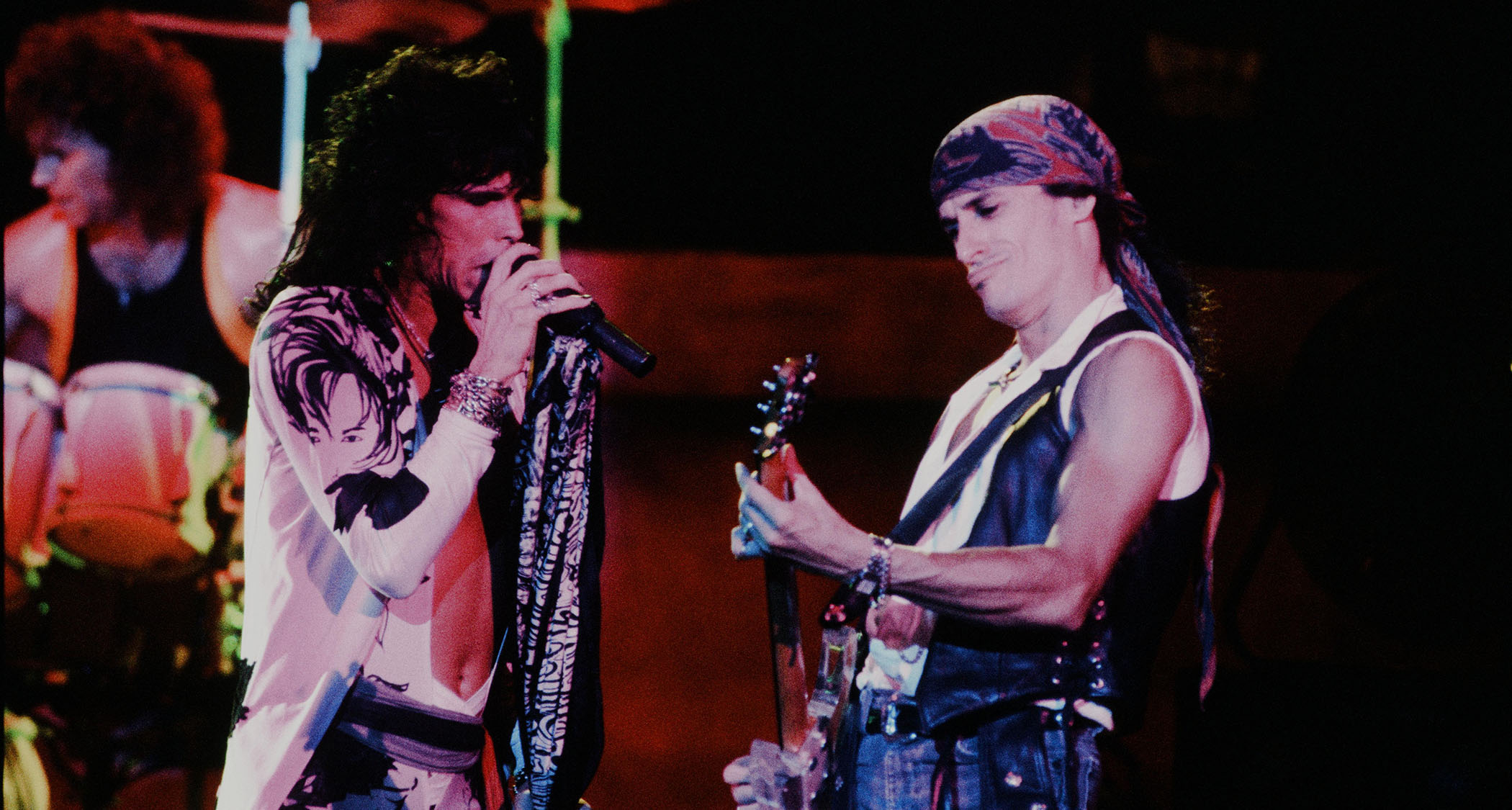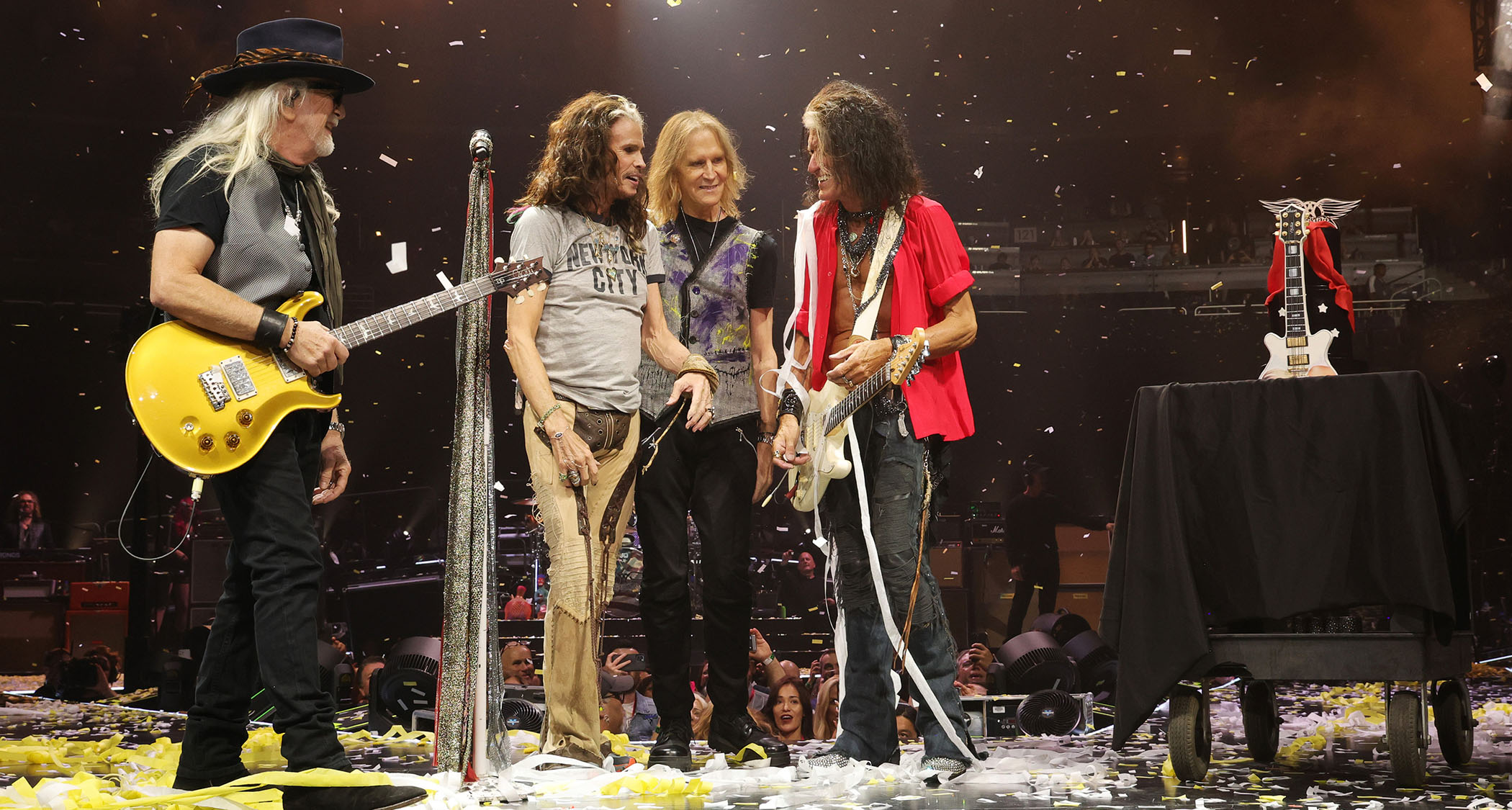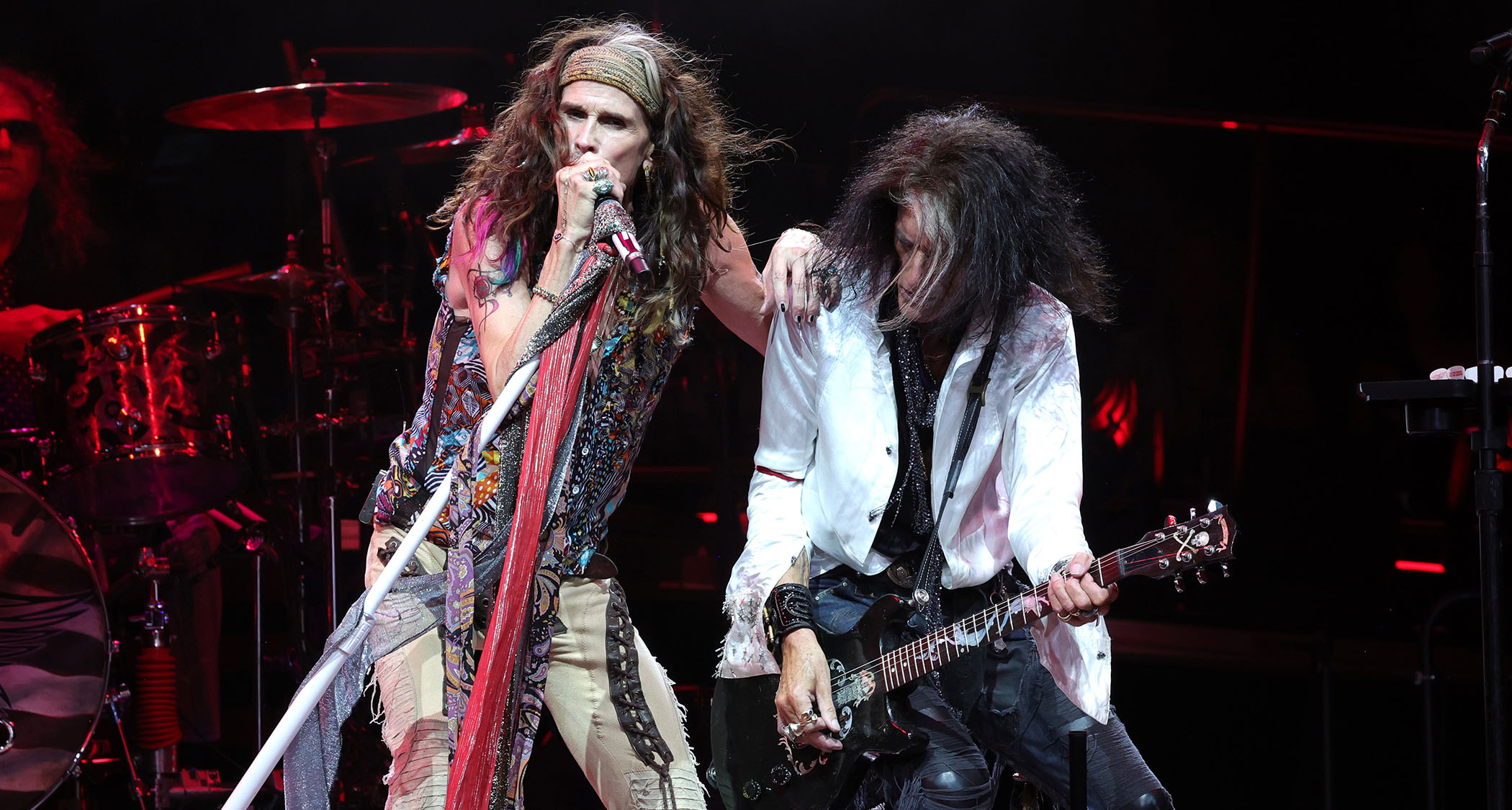“I got food poisoning. When I’d stopped throwing up, the first thing we did was the solo for Love In An Elevator”: Joe Perry on the unlikely origins of Aerosmith’s greatest guitar moments – and the big regret of his 600-strong guitar collection
With the Peace Out Tour bringing the curtain down on America's greatest rock 'n' roll band, Joe Perry joins us to take us back to the start for a career-spanning interview
The comeback album Done With Mirrors was not a huge success, but then you had the collaboration with Run-DMC on Walk This Way, which introduced Aerosmith to a whole new generation. And then you had multi-platinum albums with 1987’s Permanent Vacation and 1989’s Pump. Did the band feel at home in the MTV era?
“Well, you had to get a great video for your single and all that sh*t. The whole industry had changed. Touring was different. It had become more of an industry, so it wasn’t just about a great song but also having a great video. Then you could go out and sell tickets.”
Songs like Dude (Looks Like A Lady) did the trick, though.
“With Dude, I loved AC/DC. That band still f*cking knocks me out! Their early albums – pick any album – they’re all great. So, with Dude, I was thinking about an AC/DC song. And it’s funny, it doesn’t sound like an AC/DC song, but there you go!
“I remember around that time Steven had gotten a sampler, which had just come out. He pressed a button, and you could shorten things, and another button would make it repeat. So suddenly you’ve got this cool rhythm thing, and we were fooling around with that. That riff you hear at the start came from Steven fooling with the buttons, and we captured that stuttering riff. We built the song from that.”

And how about Love In An Elevator, another big hit?
“With that one, we were in Vancouver working on the record and we had this guy following us around with a video camera. He was trying to capture those moments when you’re searching for the right riff, lyric or whatever, and you get hit by lightning.
All the latest guitar news, interviews, lessons, reviews, deals and more, direct to your inbox!
“So we had the camera going, and fortunately, we’d keep the tape or audio to get that moment, because you never knew when it would hit. So that’s why you see those moments when you watch The Making Of Pump video.
“With Elevator, I remember we had the four or five chords, but we needed a riff that worked, and we ended up getting that on video. When you need something, sometimes it’s right there, but other times, you don’t know where the f*ck it comes from!”
The solos in Love In An Elevator are classic, too.
“While doing Pump, sometimes we’d work on Saturdays, but we’d usually take Sunday off. So Steven, me and our wives decided to head to Vancouver Island, and I got food poisoning. But by the time we came back to the studio, I was feeling better, I’d stopped throwing up, and the first thing we did was work on the solo for Love In An Elevator.
“Half of it was pretty much the first take, and then we probably put a few edits in. It’s one of those songs that, to this day, when I do it live, I stay as close to the record as I can.”
The Gearhead
With the 1993 album Get A Grip, you were becoming experimental with gear and sounds. What prompted that?
“That was the beginning of the period when I really got into amps. I remember telling Brad that I was having trouble getting the sound I wanted, and he said, ‘It would help if you got some really good amps!’ So that’s when I really got into that stuff. But with a song like Fever, the beginning has sound effects.
“I recorded that in my studio while fooling around with some rack-mounted stuff. By then, I’d really learned how to go to the next level because I wasn’t happy with some of the quality of the recordings to that point. I was learning how to produce, engineer, and get really good sounds, along with what gear to use. I got into that a lot.
“On the first record, I didn’t know any of that stuff, and I’d ask producers and engineers, ‘How did you get that sound?’ So I learned about it, and Get A Grip was when I started to learn how to use it.”

Aerosmith haven’t made an album since Music From Another Dimension in 2012, but you’ve recorded and toured with the Hollywood Vampires. Do you approach that band much differently from a guitar perspective?
“I don’t feel like there’s any set rules. It’s all about experimenting. If I’m gonna go in and record, or someone wants me to do an overdub or a solo, it all depends on the song. But there’s no pressure to do anything other than see a smile on somebody else’s face in the band.
“Some bands have hard and fast rules about how the guitars have to sound or who needs to be the only one playing a solo, but it’s all about the song. Above all else, it’s about what’s right for the song. And the other guys in the band are great players. Both Johnny [Depp] and Tommy [Henriksen] are formidable. You’re all part of the game.”
But it’s different from Aerosmith.
“It’s such a different set of… I don’t want to say rules, there are no rules. But there’s a certain freedom to just go in there and just do what you do. And Johnny, he’s a musician first. He always wanted to be in a band, so watching him blossom in the studio is great. Man, he can really play!”
A year or so back, you said that there are no bad tones. I love that idea. It’s freeing…
“When you just think about what works for the song, there are no bad tones. Dude (Looks Like A Lady) was inspired by Steven using samples, and it turned into this effect that when we play live a keyboard player triggers it. But what inspired that song was chord changes, a riff and a guitar. The melody came after. And it’s a song that people love to hear.”
Think again if you need to spend a whole bunch of money on an original Klon to get that sound. There’s some affordable stuff out there that can do the same thing
Another thing that should be talked about more is that you’ve become a mad scientist when it comes to pedals and amps.
“Oh, man, that’s one thing I’m constantly doing – looking at new pedals. Electro-Harmonix has come out with a ton of great stuff. I don’t know enough about all the circuitry to tell you the difference between one distortion and another in that way. All I know is that if your preamp isn’t hot enough, it’s not going to drive the power amp enough to get the kind of distortion that you want.”
You came up in the days when most players pushed their tube amps for distortion, but now you’ve got pedals to do it for you. What has that been like?
“Well, that classic sound and those early effects back then were interesting. You had your clean sound, and then you had that dirt, like the distortion. All of that happened by accident, and according to the legend, depending on who you believe about amps falling off trucks or whatever, distortion came from that, and they said, ‘Well, okay, let’s use it anyway!’
If it’s amps or pedals, I don’t think there’s any place where you can say, ‘I’ve found the perfect tone’, because there are no bad tones
“We’re talking about old songs like Rocket 88 [widely considered to be the first rock ’n’ roll record, sung by Jackie Brenton with Ike Turner on guitar] and Rumble [Link Wray’s 1958 instrumental featuring innovative use of distortion]. And then somebody came along with valve amps with certain transistors, capacitors, and transformers that get distorted when you take it to 10. It’s magic!
“So, from the ’50s to the ’60s, it became like its own voice, and of course, Marshall and the other English amp companies jumped on that because you had these guys who wanted more volume. People still chase that sound that Clapton had with the Bluesbreakers.
“Ted Nugent once said to Eddie Van Halen, ‘If I had your gear, I’d sound like you’. But he plugged in and sounded like Ted. So if it’s amps or pedals, I don’t think there’s any place where you can say, ‘I’ve found the perfect tone’, because there are no bad tones.”
It’s also important to remember that many tones people are chasing through vintage gear came about when that gear was new years ago.
“Right, so you can go back and find the exact same amp and same guitar, and now they’re all 50, 60, 70 years old. That’s not the same. My point is that those instruments, back then, were pretty new.
“Big legacy companies like Gibson and Fender are now starting to make guitars that are as good as the ones they made back when they were first invented. I’ve played some new Gibson and Fenders that really nail it. And the boutique companies, money aside, have hit the nail on the head and are making great instruments, too. So I’m always looking at guitar magazines and the latest pedals.
“There are some pedals that, for example, if you’re dealing with a Klon, it would be tough to decide between them during a blindfold test. So think again if you need to spend a whole bunch of money on an original Klon to get that sound. There’s some affordable stuff out there that can do the same thing.”
50 years. 600 guitars. And one billion streams…
You’ve dedicated 50 years to Aerosmith, and in all that time you’ve amassed a huge collection of guitars – in excess of 600 at the last count. But is there one guitar that means the most to you these days?
“There’s a Strat that has changed a bunch since around 2001 that I call the ‘Burned Strat’. It changes every six months, kind of for the fun of it. But there are some legitimate sonic reasons that I’ve got set up with a left-handed neck, like the length of the strings from the nut to the tuning pegs, all these little things.
“And I’ve got this great set of Seymour Duncan pickups that can switch back and forth between single-coil and P-90 sound. They’re great, and I’m surprised you don’t see them talked about more in guitar magazines.”

And when you look back on all that you have achieved, how do you measure the importance of what you’ve accomplished from a guitar perspective?
“I recently saw that Dream On went over one billion streams. One billion. That’s insane! I never imagined that would happen. And the first thing you hear when that song comes on is my guitar. That means a lot to me. The space between when I got my first Silvertone guitar and when I recorded Dream On seemed like a minute. So for that song to be over a billion and reach as many people as it has, that’s pretty special.
“When you start, you can’t imagine these types of things, so to have it reach so many people, and for us to be ready to get back out there again for this tour, I don’t take any of that for granted. That’s the biggest thing – at my age, you learn not to take anything for granted and enjoy it.”
Andrew Daly is an iced-coffee-addicted, oddball Telecaster-playing, alfredo pasta-loving journalist from Long Island, NY, who, in addition to being a contributing writer for Guitar World, scribes for Bass Player, Guitar Player, Guitarist, and MusicRadar. Andrew has interviewed favorites like Ace Frehley, Johnny Marr, Vito Bratta, Bruce Kulick, Joe Perry, Brad Whitford, Tom Morello, Rich Robinson, and Paul Stanley, while his all-time favorite (rhythm player), Keith Richards, continues to elude him.







